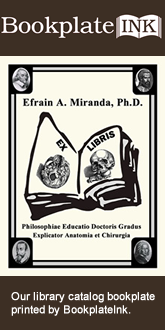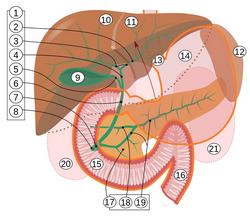
Medical Terminology Daily (MTD) is a blog sponsored by Clinical Anatomy Associates, Inc. as a service to the medical community. We post anatomical, medical or surgical terms, their meaning and usage, as well as biographical notes on anatomists, surgeons, and researchers through the ages. Be warned that some of the images used depict human anatomical specimens.
You are welcome to submit questions and suggestions using our "Contact Us" form. The information on this blog follows the terms on our "Privacy and Security Statement" and cannot be construed as medical guidance or instructions for treatment.
We have 988 guests online

Georg Eduard Von Rindfleisch
(1836 – 1908)
German pathologist and histologist of Bavarian nobility ancestry. Rindfleisch studied medicine in Würzburg, Berlin, and Heidelberg, earning his MD in 1859 with the thesis “De Vasorum Genesi” (on the generation of vessels) under the tutelage of Rudolf Virchow (1821 - 1902). He then continued as a assistant to Virchow in a newly founded institute in Berlin. He then moved to Breslau in 1861 as an assistant to Rudolf Heidenhain (1834–1897), becoming a professor of pathological anatomy. In 1865 he became full professor in Bonn and in 1874 in Würzburg, where a new pathological institute was built according to his design (completed in 1878), where he worked until his retirement in 1906.
He was the first to describe the inflammatory background of multiple sclerosis in 1863, when he noted that demyelinated lesions have in their center small vessels that are surrounded by a leukocyte inflammatory infiltrate.
After extensive investigations, he suspected an infectious origin of tuberculosis - even before Robert Koch's detection of the tuberculosis bacillus in 1892. Rindfleisch 's special achievement is the description of the morphologically conspicuous macrophages in typhoid inflammation. His distinction between myocardial infarction and myocarditis in 1890 is also of lasting importance.
Associated eponyms
"Rindfleisch's folds": Usually a single semilunar fold of the serous surface of the pericardium around the origin of the aorta. Also known as the plica semilunaris aortæ.
"Rindfleisch's cells": Historical (and obsolete) name for eosinophilic leukocytes.
Personal note: G. Rindfleisch’s book “Traité D' Histologie Pathologique” 2nd edition (1873) is now part of my library. This book was translated from German to French by Dr. Frédéric Gross (1844-1927) , Associate Professor of the Medicine Faculty in Nancy, France. The book is dedicated to Dr. Theodore Billroth (1829-1894), an important surgeon whose pioneering work on subtotal gastrectomies paved the way for today’s robotic bariatric surgery. Dr. Miranda.
Sources:
1. "Stedmans Medical Eponyms" Forbis, P.; Bartolucci, SL; 1998 Williams and Wilkins
2. "Rindfleisch, Georg Eduard von (bayerischer Adel?)" Deutsche Biographie
3. "The pathology of multiple sclerosis and its evolution" Lassmann H. (1999) Philos Trans R Soc Lond B Biol Sci. 354 (1390): 1635–40.
4. “Traité D' Histologie Pathologique” G.E.
Rindfleisch 2nd Ed (1873) Ballieres et Fils. Paris, Translated by F Gross
"Clinical Anatomy Associates, Inc., and the contributors of "Medical Terminology Daily" wish to thank all individuals who donate their bodies and tissues for the advancement of education and research”.
Click here for more information
- Details
This article is part of the series "A Moment in History" where we honor those who have contributed to the growth of medical knowledge in the areas of anatomy, medicine, surgery, and medical research.

Alexander Monro Secundus
Alexander Monro Secundus (1733- 1817). Scottish physician and anatomist, born in Edinburgh. Alexander Monro Secundus (the second), studied anatomy with his father Alexander Monro Primus (the first). He received his doctorate in medicine at 22 years of age. His studies led him to write on the lymphatic system, leading to a public written dispute with William Hunter. In 1753 he demonstrated the communication channels between both lateral and third ventricle of the brain, describing it in a published work in 1797. Since then, these channels have been know as the foramina of Monro. Later analysis of prior publications demonstrate that these foramina were known, although probably not well understood.
The Monro family gave history three anatomists who occupied the chair of Anatomy at the University of Edinburgh for over a century. Alexander Monro Primus (1697 - 1767), Alexander Monro Secundus (1733 - 1817), and Alexander Monro Tertius (1773 - 1859)
Sources:
1. Sharp, J. A. (1961). Alexander Monro secundus and the interventricular foramen. Medical History, 5(1), 83
2. Wu, O. C., Manjila, S., Malakooti, N., & Cohen, A. R. (2012). The remarkable medical lineage of the Monro family: contributions of Alexander primus, secundus, and tertius. Journal of neurosurgery, 116(6), 1337-1346.
3. "The origin of Medical Terms" Skinner, HA; 1970
Original image: Coloured stipple engraving by James Heath (1757–1834), after Henry Raeburn (1756–1823) [Public domain], via Wikimedia Commons
- Details
The chordae tendineae, as their Latin name suggests, are tendinous cords found in the right and left ventricles of the heart. These chordae tendineae connect the papillary muscles to the leaflets of the atrioventricular (AV) valves. The vernacular term for these structures is "heart strings".
The function of the chordae tendineae is to limit the freedom of motion of the cusps of the AV valves (tricuspid and mitral), limiting their capacity to "flap" back into the corresponding atrium. Rupture of one or more chordae can cause retrograde flow (reflux or regurgitation) of blood from the ventricle into the atrium, causing cardiac dysfunction.
The chordae tendineae are part of a larger complex of interacting anatomical structures that include the fibrous "skeleton of the heart", the fibrous core of the AV valves, the chordae tendineae, the papillary muscles, and the complex fibrous internal structure of the papillary muscles and the ventricular wall.
The image shows the dissection of a human heart, with the right atrium open. The fan-like shape of the many chordae tendineae is clearly visible, spanning two leaflets. Observe that some chordae tendineae arise directly from the interventricular septum. These are known as the "septal chordae tendineae". Observe the atrioventricular sulcus, and the cardiac apex.
Image property of: CAA.Inc.
- Details
The [common hepatic duct] is one of the components of the extrahepatic hepatobiliary tree that takes bile produced in the liver and transports it to the duodenum, with a storage function in the gallbladder.
The common hepatic duct (CHD) is formed by the junction of the right and left hepatic ducts which bring bile from the right and left functional lobes of the liver respectively. These hepatic ducts converge forming an obtuse angle.
During its trajectory the CHD is found between the layers of the lesser omentum. It has anatomical relations with the proper hepatic artery and the portal vein.
The CHD has an average diameter of 4 to 5 mm and an average length of 3cm (Testut & Latarjet 1931). It ends at the point of origin of the cystic duct which takes bile to the gallbladder. The CHD continues with the common bile duct, which empties into the second portion of the duodenum through the hepatopancreatic ampulla, also known as the Ampulla of Vater.
As with all the components of the hepatobiliary tree, the CHD presents with many anatomical variations. In cases the CHD has been reported with a length of 42 mm, and as short as 3 mm.
Following is the key to the image: 1. Bile ducts: 2. Intrahepatic bile ducts 3. Left and right hepatic ducts, 4. Common hepatic duct 5. Cystic duct 6. Common bile duct 7. Ampulla of Vater 8. Major duodenal papilla 9. Gallbladder 10–11 Right and left lobes of liver 12. Spleen. 13. Esophagus 14. Stomach Small intestine: 15. Duodenum, 16. Jejunum 17. Pancreas: 18: Accessory pancreatic duct, 19: Pancreatic duct. 20–21: Right and left kidneys (silhouette). The anterior border of the liver is lifted superiorly (brown arrow). Gallbladder in longitudinal section, pancreas and duodenum in frontal section. Intrahepatic ducts and stomach in transparency.
Sources:
1. "Tratado de Anatomia Humana" Testut et Latarjet 8 Ed. 1931 Salvat Editores, Spain
2. "Gray's Anatomy" 38th British Ed. Churchill Livingstone 1995
Original image (Public domain) by Jmarchn (Own work) [CC BY-SA 3.0 (http://creativecommons.org/licenses/by-sa/3.0) or GFDL (http://www.gnu.org/copyleft/fdl.html)], via Wikimedia Commons
- Details
The simplest definition of the prefix [pro-] is that it means “forward”. The truth is quite more complicated.
This prefix, used in vernacular English, actually has two different origins and meanings. One arises from the Latin [pro], meaning “on behalf of”, or “in favor of”, and as such we see it in the words proactive, pro-independence, and prohibition.
The second meaning comes from the Greek [πρό] (pr?) meaning “before” and “fore”. This evolved into “in front of” and later to “forward”, which is the main meaning used in medical terminology, as in the words prognosis and prolapse.
- Details
The root term [-gnath-] arises from the Greek word [γνάθος] (gn?thos) meaning “jaw” or “jaw bone”. It is used in medical terms referring to jaw pathology,
- Prognathism or prognathia: The prefix [pro-] means “forward”. A protrusion of the jaw
- Retrognathism or retrognathia: The prefix [retro-] means “posterior”. A posterior displacement caused by lack of development of the jaw
- Micrognathia: The prefix [micro-] means “small”. A small jaw
All these words (prognathism, retrognathism, and micrognathism) are examples of dysmorphism. The accompanying image shows a case of acromegaly with consequent prognathism due to overdevelopment of the jaw.
Note: The links to Google Translate include an icon that will allow you to hear the pronunciation of the word.
Image: By Philippe Chanson and Sylvie Salenave [CC BY 2.0 (http://creativecommons.org/licenses/by/2.0)], via Wikimedia Commons
- Details
UPDATED: The word [sphincter] derives from the Greek [σφιγκτήρ] (sfinkt??r), with the same meaning, in turn arising from the Greek word [σφιχτός] (sficht?s) meaning "tight". . The term was originally used by Galen (129AD - 200AD) in the meaning of "to bind tight" or "that which binds tight".
A sphincter is an area of circular muscle fibers that controls a canal or an opening. Rufus named some of them, because of their shape, [orbicularis], a Latin term meaning "circular". An example of this nomenclature are the [orbicularis oculi] and the [orbicularis ori] muscles, the circular muscles of the eye and mouth, respectively.
Some of the so-called "sphincters" in the body are functional sphincters, that is, they control a canal mostly because of their shape, not because of the constrictive action of their circular muscle fibers, such as the ileocecal sphincter or valve, which is normally a one-way valve or a check-valve (shown in the picture)
Other sphincters are true anatomical sphincters, where the number and strength of their circular fibers close off the lumen of the organ, but these are not one-way valves. An example of this type of sphincter is the pylorus.
Images and links public domain, courtesy of: www.bartleby.com





